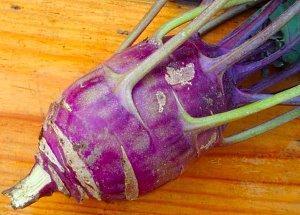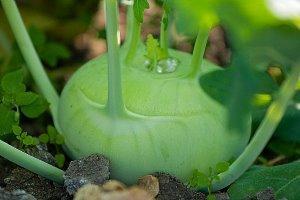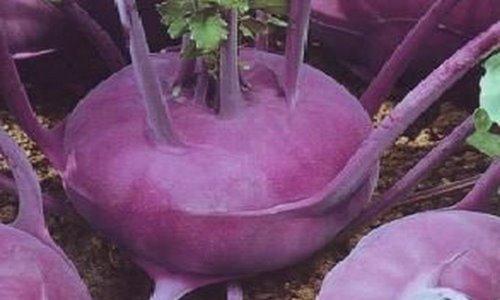Kohlrabi cabbage - all the secrets of growing a juicy stem
 Kohlrabi is a type of cabbage, a feature of which is a stem-grower, which has a rounded shape. It has a delicate sweetish taste and is used for making salads, side dishes, casseroles. In addition to its taste, kohlrabi cabbage is rich in vitamins and minerals. And the low calorie content makes the vegetable a valuable product in the diet. How to grow kohlrabi cabbage outdoors?
Kohlrabi is a type of cabbage, a feature of which is a stem-grower, which has a rounded shape. It has a delicate sweetish taste and is used for making salads, side dishes, casseroles. In addition to its taste, kohlrabi cabbage is rich in vitamins and minerals. And the low calorie content makes the vegetable a valuable product in the diet. How to grow kohlrabi cabbage outdoors?
Description and photo of kohlrabi cabbage

Early varieties of kohlrabi cabbage allow you to harvest several times per season, but they are unsuitable for long-term storage and require immediate processing. With a competent approach, late varieties can delight with their taste all winter. For this, the stems are sprinkled with moistened sand and placed in the basement.

Growing kohlrabi cabbage from seeds for seedlings
For an early harvest seedlings are grown on windowsills... This method allows you to get stem fruits already at the beginning of summer. Kohlrabi cabbage is grown from seeds for seedlings in mid-March. It is important to prepare the planting material in order to reduce the risk of diseases such as powdery mildew, black leg, various fungal infections.
How to process planting material:
- You need to place the seeds in a cloth and hold them in hot water at 50-60 degrees for half an hour.
- Refrigerate for 10 minutes in cold water.
- Leave for 12 hours for the seeds to swell in a room at room temperature.
- Place in the refrigerator for a day.
- For flowability, the seeds can be dried a little by holding them in the air.
Sowing is carried out in pre-prepared soil, consisting of sand and sod land in a 1: 1 ratio. You can add a little humus and ash... For disinfection, the soil is spilled with a manganese solution (1 g per 10 liters of water). You can grow kohlrabi cabbage from seeds for seedlings immediately in individual cups or into boxes with subsequent picking. The second method is better, as it allows you to get stronger and stronger plants.

For sowing, grooves are cut in the soil, at a distance of 3-4 cm from each other. The seeds are laid to a depth of 1 cm, the distance between them is maintained 1-2 cm. Sprinkle with loose earth on top and remove the box on the windowsill. When seedlings appear, it is necessary to remove the seedlings to a cooler place with a temperature of 10-15 degrees for several days to prevent the plants from pulling out. After 2 weeks, you can start picking into individual cups. The stemfruit can be grown both in greenhouses, and in the open field.
How to grow kohlrabi cabbage outdoors?
For a later harvest, sowing can be done directly into the ground or in hotbeds... In this case, the pick is carried out immediately to a permanent place.The technology of how to grow kohlrabi cabbage in the open field for seedlings is no different from the method on the windowsill. Despite the fact that kohlrabi tolerates frost well, when planting early, it is recommended to cover the plants with non-woven material at night.

Well-lit places with fertile, light soil are suitable for planting kohlrabi cabbage seedlings. Good predecessors: legumes, potatoes, tomatoes, bow... To avoid diseases and pests, do not plant seedlings after other cruciferous plants. Before planting, manure can be added to the ground compost... Fresh manure it is not recommended to apply, as it increases the risk of being hit by a fly.
For early varieties, a distance between rows of 30 cm is sufficient, and between plants 25. For mid-ripening and late ones 40 and 30, respectively. Unlike other types of cabbage, this one does not need to be deepened, since the fruit forms on the stem.
Caring for kohlrabi cabbage
A week after planting the plant in a permanent place, you can do top dressing nitrogen fertilizer... After 2-3 weeks after it, you can feed with fermented organic matter. And the last make-up is done with a solution superphosphate with potassium.
Proper care of kohlrabi cabbage includes:
- Regular watering... It is carried out at least 1 time in 3 days.
- Loosening the soil.
- Pest and disease control.
Cabbage especially needs competent watering during the formation of a stem crop. A deficiency can adversely affect formation, and an excess can lead to cracking. It is important to avoid stagnant water while maintaining moderate humidity. For pest and disease control, the same means are used as for white cabbage... Loosening takes a special place. It contributes to the saturation of the soil with oxygen. It is important to carry it out carefully so as not to damage the stem and not sprinkle it with soil.

Valuable tips for growing kohlrabi
Many gardeners do not dare to grow kohlrabi and still consider it an overseas vegetable. In fact, agricultural technology is simple and this type of cabbage grows well in our climatic conditions.
Tips for growing kohlrabi:
- To eat from the beginning of summer until frost, you need to plant several varieties of different ripening periods. Late ones will survive well until February.
- Before planting home seedlings in the ground, hardening must be carried out for several days.
- If there is not enough space for a kohlrabi bed, then it can be planted between other crops as a sealant. She gets along well with almost all neighbors.
- Harvesting is best done earlier, without overripe. As soon as the stem grower reaches 7 cm in diameter, it can be eaten.
- Late varieties are less prone to woody stems.
- For storage, the crop is harvested and laid along with the root.
These simple tips for growing kohlrabi will make the process easier and help you get a good harvest of succulent stems.